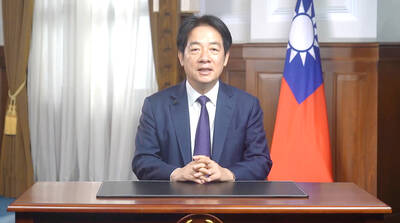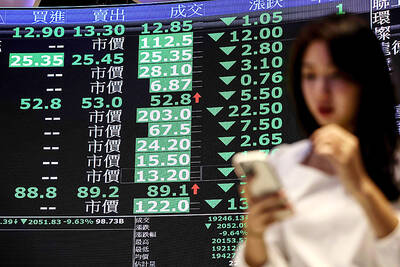Taiwan's newly established Coast Guard Administration (CGA) has plans to establish a "three-dimensional" monitoring capability and an island-wide surveillance system as one of its future functions, said the new director Wang Chun (王郡).
"The three-dimensional monitoring capability is to be developed through the build-up of on-the-shore, coastal, ocean-going and air forces. We hope to reach the goals in a given time, but we know that we are still in the infancy stage compared to coast guard forces of advanced countries," Wang said.
Wang said the coast guard also has ambitious plans to have three 5,000-tonne large-sized vessels built. The 5,000-tonne ship will dwarf any warship presently in service in the navy.
So far, the biggest ships operational in the coast guard are eight 1,900-tonne vessels handed over from the customs authorities.
"We have not made a final decision on whether to go ahead with the 5,000-tonne ship building plan. We have to consider many factors, especially the cost," Wang said.
Officials with the CGA said the 5,000-tonne ships would be equipped with helicopters, which would significantly upgrade the search and rescue capability of the coast guard.
The ship building plan is just one part of Wang's project to develop a three-dimensional monitoring system, which could cover areas from the coast to the sea, and from the ground to the air.
Wang said the purpose of the "three dimensional" approach was to carry out missions from the coast to the high seas.
"Our aim is to effectively enforce law within our 200 nautical mile economic zone. We hope to achieve it, though it is not going to be an easy job," Wang said.
In addition to the upgrade in the coast guard's monitoring capability, Wang said another priority was to establish a surveillance network around the island using high-tech equipment as well as personnel networking.
"Taiwan has a coastline of 1,500km. We do not expect our surveillance systems to cover every spot along the coast. We will build it selectively on spots prone to smuggling activities," Wang said.
Officials with the CGA said the surveillance system, comprised of radar, infrared sensors, sonar, as well as image scanning equipment, costs around NT$20 million for every kilometer. The total cost will run as high as NT$160 billion if the system is to comprehensively cover the coastline.
Because of budgetary constraints, Wang said the CGA will look to civilians for assistance in establishing a toll-free hotline to report unusual sightings off or along the coast.

ACTION PLAN: Taiwan would expand procurement from the US and encourage more companies to invest in the US to deepen bilateral cooperation, Lai said The government would not impose reciprocal tariffs in retaliation against US levies, President William Lai (賴清德) said yesterday, as he announced five strategies to address the issue, including pledging to increase Taiwanese companies’ investments in the US. Lai has in the past few days met with administrative and national security officials, as well as representatives from various industries, to explore countermeasures after US President Donald Trump on Wednesday last week announced a 32 percent duty on Taiwanese imports. In a video released yesterday evening, Lai said that Taiwan would not retaliate against the US with higher tariffs and Taiwanese companies’ commitments to

Intelligence agents have recorded 510,000 instances of “controversial information” being spread online by the Chinese Communist Party (CCP) so far this year, the National Security Bureau (NSB) said in a report yesterday, as it warned of artificial intelligence (AI) being employed to generate destabilizing misinformation. The bureau submitted a written report to the Legislative Yuan in preparation for National Security Bureau Director-General Tsai Ming-yen’s (蔡明彥) appearance before the Foreign Affairs and National Defense Committee today. The CCP has been using cognitive warfare to divide Taiwanese society by commenting on controversial issues such as Taiwan Semiconductor Manufacturing Co’s (TSMC, 台積電) investments in the

HELPING HAND: The steering committee of the National Stabilization Fund is expected to hold a meeting to discuss how and when to utilize the fund to help buffer the sell-off The TAIEX plunged 2,065.87 points, or 9.7 percent, to close at 19,232.35 yesterday, the highest single-day percentage loss on record, as investors braced for US President Donald Trump’s tariffs after an extended holiday weekend. Amid the pessimistic atmosphere, 945 listed companies led by large-cap stocks — including Taiwan Semiconductor Manufacturing Co (TSMC, 台積電), Hon Hai Precision Industry Co (鴻海精密) and Largan Precision Co (大立光) — fell by the daily maximum of 10 percent at the close, Taiwan Stock Exchange data showed. The number of listed companies ending limit-down set a new record, the exchange said. The TAIEX plunged by daily maxiumu in just

‘COMPREHENSIVE PLAN’: Lin Chia-lung said that the government was ready to talk about a variety of issues, including investment in and purchases from the US The National Stabilization Fund (NSF) yesterday announced that it would step in to staunch stock market losses for the ninth time in the nation’s history. An NSF board meeting, originally scheduled for Monday next week, was moved to yesterday after stocks plummeted in the wake of US President Donald Trump’s announcement of 32 percent tariffs on Taiwan on Wednesday last week. Board members voted to support the stock market with the NT$500 billion (US$15.15 billion) fund, with injections of funds to begin as soon as today. The NSF in 2000 injected NT$120 billion to stabilize stocks, the most ever. The lowest amount it